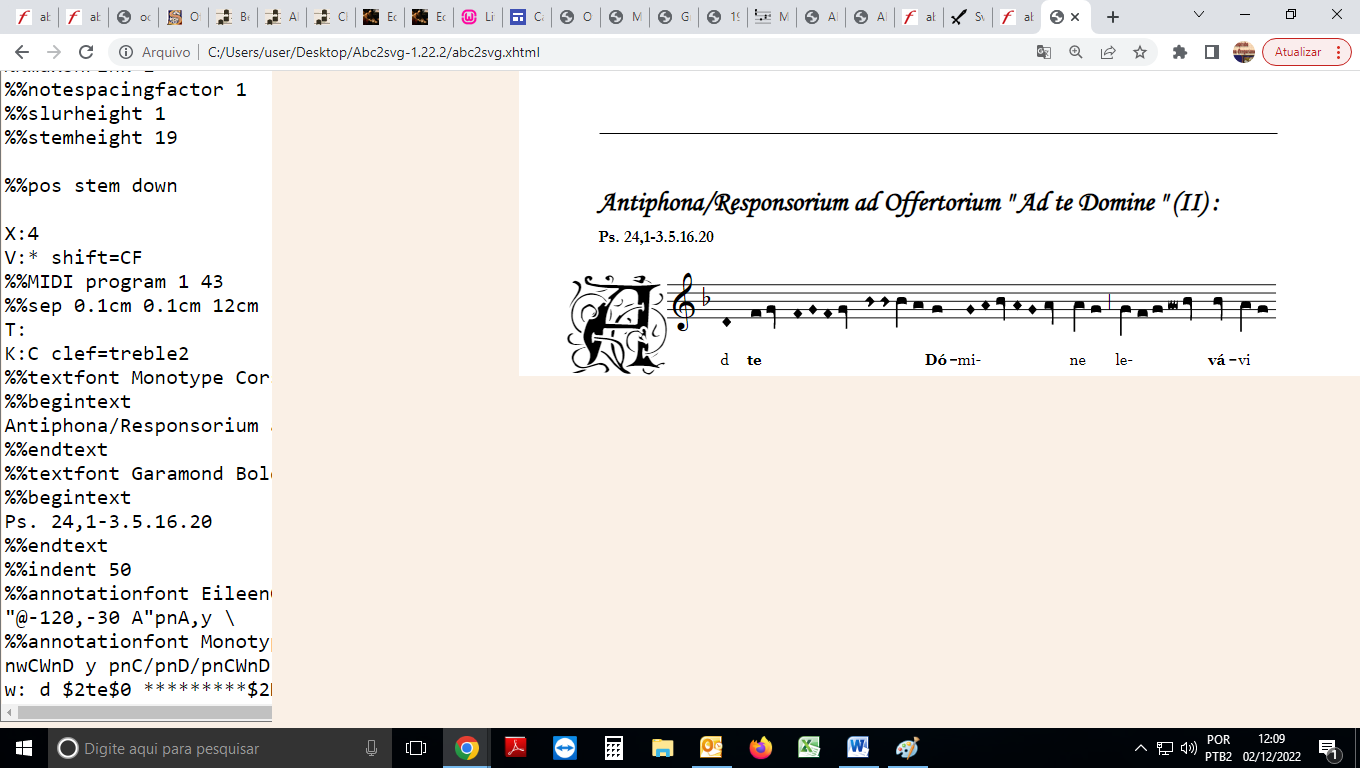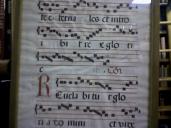5 line chant notation?
-
It that one of those Elephant folios? http://www.ebay.com/itm/1700s-ANTIPHONARY-Elephant-Folio-GREGORIAN-CHANT-Illuminated-MUSIC-Manuscript-/321379559689?pt=Antiquarian_Collectible&hash=item4ad3b6e909 There's one for sale on eBay, also with five lines. I noticed Perotin mixes both five and four line staves, reserving the four line staff for the cantus firmus, a half millennium before the 1700s.
-
It is not as if the number of _four_ lines in chant notation was carved in stone. In the beginning there was not a single line, as all know who have looked at adiastematic manuscripts. Some time later scribes started to scratch lines in the parchment so it became easier to distinguish between high and low notes through vertical placement. Some monk thought it advisory to draw this line in ink and it went on to more and more lines over time. This did not happen everywhere, the monks of St Gall sang from adiastematic neumes even in the 14th century, whereas at other places three, four or five lines were commonplace. It is simply a matter of custom, just as it is now customary to write modern music notation on staffs of five lines; when you look into older manuscripts of e.g. organ music, you can also see seven line staffs for the left hand. The five line staffs became customary first amongst italian organists and spread from there.
-
The five-line staff was used for chant in Spain and the Spanish-speaking world until the nineteenth century.Thanked by 1Lincoln_Hein
-
Corpus Christi Watershed recently posted a 5-line gradual from Germany:
https://www.ccwatershed.org/2022/11/25/pdf-download-gradual-book-traditional-notation-on-modern-staves-692-pages/
I myself own the same book printed 19 years before the edition they posted, so it *seems* to have been quite popular in fin de siecle Germany/Austria -
I think that PDF is BRILLIANT. I even went back and edited the section for Advent and Christmas to underlay English translations, so I can keep it on the organ as improvisational fodder. It makes it SO much easier for people to figure out how to read all the pitches, and honestly, I would like to see a modern edition of the current Gregorian Missal issued this way. I showed it to a few choir members and they were all amazed because they thought it made reading the notation so much easier. It is a nearly perfect synthesis of both forms of notation.
-
In some modes, we don't need 5 lines or a treble clef to read the chant in treble clef.Thanked by 1Patricia Cecilia
-
True, but this takes all the guess work out of it for people who don't know how to parse out the modes, or who have difficulty remembering where to place the half-step intervals.Thanked by 1Lincoln_Hein
-
Using the abc2svg editor and some codes (https://forum.musicasacra.com/forum/discussion/20449/chant-notation-on-abc2svg-abcnotation#Item_4)
I achieved this:

 modern-square3.png1360 x 768 - 123K
modern-square3.png1360 x 768 - 123K
Welcome to the MusicaSacra Forum!
To participate in the discussions on Catholic church music, sign in or register as a forum member, The forum is a project of the Church Music Association of America.
Categories
- All Discussions21,074
- General Music Discussion8,206
- Job Openings193
- Management of Music Programs850
- Choral Matters532
- Church Documents and Rubrics524
- CMAA Notes300
- Events713
- For Newcomers: Read First26
- Sacred Polyphony546
- Hymnody871
- Gregorian Chant: General2,694
- ↳ Graduale Romanum and Liber Usualis367
- ↳ Graduale Simplex60
- ↳ Semiology63
- Vernacular Plainsong696
- Anglican Use and Anglican Chant68
- Organ, Other Instruments and Repertoire434
- New Composition/Works in Progress1,288
- Recordings230
- Music for Hispanic Ministry159
- Music Education: Children211
- Music Education: General222
- News Items245
- Positions Wanted2
- General Discussion: Catholicism738
- Amusements176
- General Discussion1,033
- Opinions117



